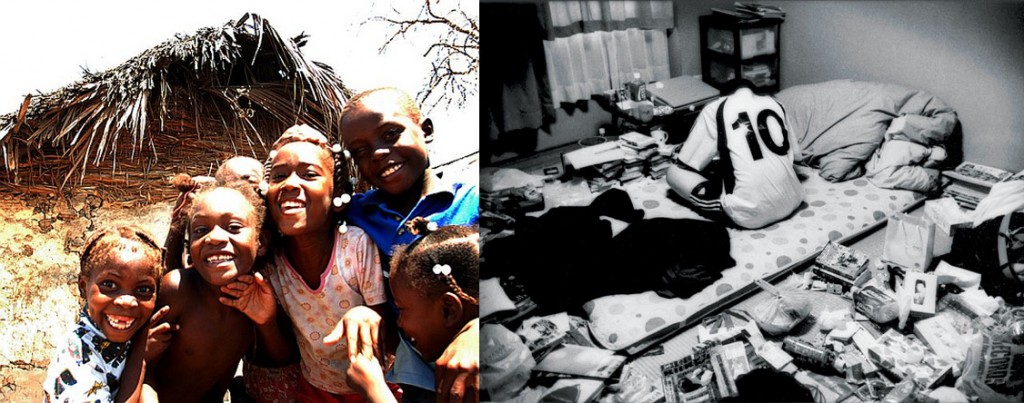DEVELOPMENT’S ILLNESS (2of 3)
EXAMINATION:
What alienating lifestyles may certain developments lead to and why?
In order to understand this mayor mismatch between development and human mental well-being I find reasonable to research from an anthropological point of view.
SETTLEMENTS: Celtic Village(North-western Europe) Massai Village(Mid-east Africa) Confucian Patriarchy Household (North-East Asia)
Universal factors in common to any grouping structure throughout history:
-Limits with regard to privacy and private space in two mayor scales.
- Community:
- -Visual limitation by structure with Defensive/Distinctive function towards the “outside”
- -Limited number of members in order to have an easier control and organization that would ensure security and performance (Decision-taking, customs, collection, preparation and consumption of food…)
- Individual Households:
- -Visual limitation by providing private un-seen spaces and shelter
- -Limited access to few group members with closest relationships
-Big clusters correspond with more developed societies as the more members a community has, the more complex is its social structure. Instead in rural villages when number of habitants increased or mayor disagreement aroused, a new village will be created with access to different crop fields or resources.
Now-a-day’s society has reached an utmost complex social structure, where at a global level the different strata have specialized in providing different services that all together make possible our every-day life. To say a few examples: Fruits from South America, fuels from the Middle-East, technology from northeast Asia…
Development and global-markets have transformed human’s natural social lifestyle where a vibrant community would work together for survival to a false independent lifestyle. We don’t rely directly on anyone else to feed or feel protected anymore, but on the wealth we make that can provide us with services. So our survival seems autonomous but we shouldn’t forget that we are will always be dependent to certain services.

Regarded as one of the features to encourage in the Gross National Happiness Report, vibrant communities give the individual a feeling of belonging, attention, leadership and protection which has a direct impact on happiness as it mitigates the feeling of loneliness and disorientation.
Actually in the first world this feeling is usually limited to households which are increasingly made out of less people: A couple and 1-2 children or an individual by himself. It’s within households that you are forced to co-exist and share space, time, costs and in the best case foster tolerance, patience and fraternity.
What messages does media instill in us?
A survey by the UK National Consumer Council, revealed that children who watch too much television and spend hours on the internet are “greedy and unhappy”
Today’s capitalism and competitiveness shapes our personality towards the eagerness and selfishness of wanting to possess things. We don’t need to share and we don’t really want to. Also we live with a constant unconscious feeling of dissatisfaction that makes us want more every time believing we will buy happiness and find perfection at some point.
[This warning about how the sense of community and real happiness is being threatened by consumerist development is very well reflected in the short-film: “Binta and the great idea” of Javier Fesser]
I also find interesting to draw a relation between extreme reliance on technology (which keeps developing at fastest pace) and social interaction problems:
Daily Needs⇒ telematic means of shopping, working, studying, online trainers…
Leisure and socializing⇒ Gaming and chats or social pages
Complete isolation is possible through technology: Welcome to future’s virtual lifestyle!
It might sound apocalyptic but indeed there is already a syndrome of extreme auto-imposed isolation that has been associated directly with development and it’s demanding expectations. For the time being, it only takes place in northeast Asia and those affected are usually teenagers and young adults that lock themselves in their room during months and even years. They are called Hikikomori, for them social confinement and virtual reality is crucial for survival and the only next step to completely escape is to commit suicide. What was meant as a tool has become the destruction of many.
[This concern is explained in the documentary “Hikikomori – Recluso Social” (social withdrawal) from Odyssey.]

In developed countries not only do children prefer TV or virtual games but adding to that, spending time outside gets more challenging. Children living in busy cities are sensibly not allowed to play outside as freely as children from more quiet villages. The issue about control and structure of large communities plays an important role in this aspect. Insecurity along with working parents that can’t look after them keep children at home, having less social interaction both with other children as with their busy family members. “Nannies” become crucial in this competitive scene. Who raises your child? Teacher? Nanny? TV?
To solve this problem, there is lately an architectural trend to build condominiums in new urban expansions. They constrain ‘safe’ comunal spaces where parents might be more confident to let their children play rather than outdoors, yet condominiums end with street life suggesting more insecurity and inequality outdoors.
I believe the design of development through architecture and urban planning should firstly bear in mind possible social repercussions due to the lock in risk these actions convey.





.png)
].gif)
.png)
].png)
].png)
].png)
.png)
].png)
.png)
